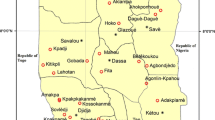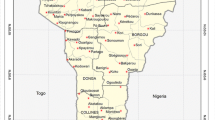Abstract
Landraces of pigeonpea (Cajanus cajan (L.) Millsp.) were collected from farmer's fields in its major cropping areas in Tanzania. Passport data, including descriptors, information on cultural practices and uses were recorded. Pigeonpea intercropping with maize, sorghum and cassava were found to be the dominating cropping systems, with characteristic differences between regions. In the northern part of the country pigeonpea has been developed into a relatively high yielding cash crop. Also in part of the Coastal Zone and Eastern Plain a market, particularly for green pods, have been developed. It is also in these areas near Dar es Salam that pigeonpea is most frequently found as a garden crop.
The study showed that farmers mainly relay on self-saved seed, but seed is also quite often provided from other sources. About one third of the farmers selected sowing seed in the field at harvest. Seed storage was considered a great problem, and a variety of indigenous storage techniques were recorded. Chemical seed dressing was only common in the Northern Highlands, where the crop plays an important role as a cash crop. In all areas pigeonpea was consumed green as well as dry. Dry pigeonpea was most often consumed as whole grains, but dehulling was common especially in the Southern Plain. Most landraces identified were long-duration types, medium-duration types only being common in the Coastal Zone. The recorded plant and seed traits varied considerably, but the frequency of landraces with relatively large white or cream seeds and large pods was high in all regions. A number of accessions with potential resistance to fusarium wilt, bruchids and pod borer were identified.
Similar content being viewed by others
References
A. Duhan N. Khetarpaul S. Bishnoi (1998) ArticleTitleImprovement in starch digestibility (in vitro) of various pigeonpea cultivars through processing and cooking Ecol. Food Nutrit. 37 557–568
H.R. Ellis R.J. Summerfield P.A. Omanga A. Qi E.H. Roberts (1998) ArticleTitleFlowering in pigeonpea in Kenya: sensitivity to photoperiod and temperature during preflowering development Expl. Agric. 34 249–258
FAO, 2002. Food and Agriculture Organization of the United Nations. Faostat-Agriculture, www.fao.org.
InstitutionalAuthorNameIBPGR and ICRISAT (1993) Descriptors for pigeonpea (Cajanus cajan (L.) Millsp.). International Board for Plant Genetic Resources, RomeItaly International Crops Research Institute for the Semi-Arid Tropics Patancheru, India 31
R.J. Hillocks E. Minja A. Mwaga M. Silim-Nahdy P. Subrahamanyam (2000) ArticleTitleDiseases and pests in pigeonpea in Eastern Africa: a review Int. J. Pest Manage. 46 7–18
R.B. Jones P.A. Audi R. Tripp (2001) ArticleTitleThe role of informal seed systems in disseminating modern varieties. The example of pigeonpea from a semi-arid area of Kenya Exp. Agric. 37 539–548
P.K. Joshi P. Parthasarathy Rao C.L.L. Gowda R.B. Jones S.N. Silim K.B. Saxena J. Kumar (2001) The World Chickpea and Pigeonpea Economies ICRISAT Patancheru, India 62
Katayama K., Adu-Gyamfi J.J., Devi G., Rao T.P. and Ito O. 1996. Balance sheet of nitrogen from atmosphere, fertilizer, and soil in pigeonpea-based intercrops. In: Ito O., Johnasen C., Adu-Gyamfi J.J., Katayama K., Kumar Rao J.V.D.K. and Rego T.J. (eds). Dynamics of Roots and Nitrogen in Cropping Systems of the Semi-Arid Tropics. JIRCAS International Agriculture Series No. 3, pp. 341–350.
P.M. Kimani (2001) Pigeonpea. Pigeonpea breeding objectives, experiences, and strategies for Eastern Africa S.N. Silim G. Mergeai P.M. Kimani (Eds) Status and Potential of Pigeonpea in Eastern and Southern AfricaProceeding of a Regional Workshop NairobiKenya12–15 September 2000 ICRISAT Patancheru, India 21–32
Kimani P.M.,Mergeai G., Silim S.N., Baudoin J.P.,RubaihayoR.P. and Janssens M. 2001. Status and potential of pigeonpea in Eastern and Southern Africa. In: Silim S.N., Mergeai G. and Kimani P.M. (eds), Proceeding of a Regional Workshop, Nairobi, Kenya, 12–15 September 2000, ICRISAT, Patancheru, India, pp. 33–35.
E.M. Minja T.G. Shanower J.M. Songa J.M.O. Aro W.T. Kawanga P.J. Mviha F.A. Myaka S. Slumpa H. Okurut-Akol C. Opiyo (1999) ArticleTitleStudies of pigeonpea insect pests and their management in KenyaMalawiTanzania and Uganda Af. Crop Sci. J. 7 59–69
J.K. Mligo (1995) Pigeonpea breeding research in Tanzania S.N. Silim S.B. King S. Tuwafe (Eds) Improvement of Pigeonpea in Eastern and Southern AfricaAnnual Research Meeting, 21–23 September 1994, NairobiKenya ICRISAT Patancheru, India 95–100
D.A. Odeny (2001) Inheritance of resistance to fusarium wilt in pigeonpea Status and Potential of Pigeonpea in Eastern and Southern Africa. Proceeding of a Regional Workshop. NairobiKenya12–15 September 2000 ICRISAT Patancheru, India 43–47
P. Remanandan (1990) Pigeonpea: genetic resources Y.L. Nene S.D. Hall V.K. Sheila (Eds) The Pigeonpea C.A.B. International Wallingford, UK 89–115
M. Silim-Nahdy S.N. Silim R.H. Ellis (1999) ArticleTitleSome aspects of pod characteristics predisposing pigeonpea (Cajanus cajan (L.) Millsp.) to infestation by Callosobruchus chinensis (L.) J. of Stored Products Res. 35 47–55
S.N. Silim (2001) Strategies and experiences in pigeonpea variety development for Eastern and Southern Africa S.N. Silim G. Mergeai P.M. Kimani (Eds) Status and Potential of Pigeonpea in Eastern and Southern Africa. Proceeding of a Regional Workshop NairobiKenya12–15 September 2000 ICRISAT Patancheru, India 11–20
S.N. Silim P.A. Omanga (2001) ArticleTitleThe response of shortduration pigeonpea lines to variation in temperature under field conditions in Kenya Field Crops Res. 72 97–108 Occurrence Handle10.1016/S0378-4290(01)00167-8
M. Silim-Nahdy J.A. Agona (2001) Integrated management of postharvest pests of pigeonpea: status and potential S.N. Silim G. Mergeai P.M. Kimani (Eds) Status and Potential of Pigeonpea in Eastern and Southern AfricaProceeding of a Regional Workshop. NairobiKenya12–15 September 2000 ICRISAT Patancheru, India 174–180
Singh L. 1991. Overview of pigeonpea improvement research: objectives, achievements, and looking ahead in the African context.In: Proceedings of the First Eastern and Southern Pigeonpea in Eastern and Southern Africa. Proceeding of a Africa Regional Legumes (pigeonpea) Workshop, 25–27 June 1990, Nairobi, Kenya, EARCAL, Nairobi, Kenya, ICRISAT, Patancheru, India, pp. 5–16.
U. Singh (1995) Processing and utilization of pigeonpea S.N. Silim S.B. King S. Tuwafe (Eds) Improvement of Pigeonpea in Eastern and Southern AfricaAnnual Research Meeting, 21–23 September 1994, Nairobi, Kenya ICRISAT Patancheru, India 133–138
M.V.K. Sivakumar S.M. Virmani (1980) ArticleTitleGrowth and resource use of maizepigeonpea and maize/pigeonpea intercrop in an operational watershed Exp. Agric. 16 1–10 Occurrence Handle10.1017/S0014479700012035
L.J.G. Maesen Particlevan der (1990) Pigeonpea: origin, history, evolution, and taxonomy Y.L. Nene S.D. Hall V.K. Sheila (Eds) The Pigeonpea C.A.B. Cambridge UK 15–46
Author information
Authors and Affiliations
Corresponding author
Rights and permissions
About this article
Cite this article
Silim, S.N., Bramel, P.J., Akonaay, H.B. et al. Cropping Systems, Uses, and Primary in situ Characterization of Tanzanian Pigeonpea (Cajanus cajan (L.) Millsp.) Landraces. Genet Resour Crop Evol 52, 645–654 (2005). https://doi.org/10.1007/s10722-003-6015-7
Received:
Accepted:
Issue Date:
DOI: https://doi.org/10.1007/s10722-003-6015-7




